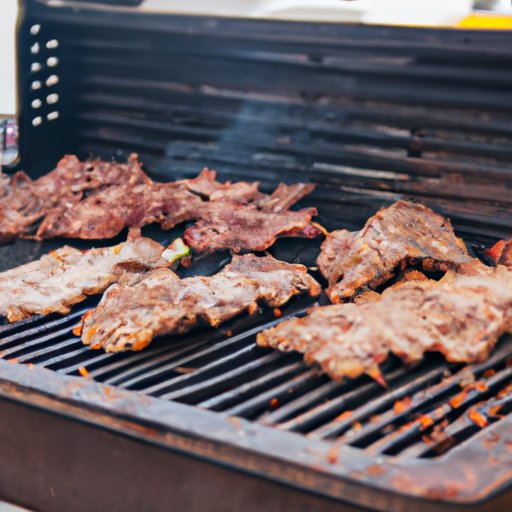
Introduction
Carne asada is a popular Mexican and Latin American dish consisting of grilled, marinated beef. This versatile dish can be enjoyed in many different settings, from casual cookouts to formal gatherings. In this article, we will provide step-by-step instructions on how to cook carne asada, explore its regional variations, offer meal pairings, provide cooking tips, discuss its health benefits, and delve into its history and culture.
Step-by-Step Guide
One of the most important aspects of cooking carne asada is marinating the meat. Marinating the meat not only adds flavor but also helps to tenderize it. Here are the steps to properly marinate and grill carne asada:
- Choose your cut of meat: Flank steak is the most commonly used cut for carne asada, but other cuts such as skirt steak or sirloin can also be used.
- Prepare the marinade: Combine ingredients such as citrus juices, garlic, cumin, chili powder, and salt in a large plastic bag or bowl.
- Add the meat to the marinade: Allow the meat to marinate for at least 2 hours or overnight in the refrigerator.
- Preheat the grill: Heat the grill to medium-high heat.
- Remove the meat from the marinade: Discard the marinade and allow excess to drip off.
- Grill the meat: Cook the meat for 4-6 minutes per side, depending on the thickness of the cut and desired level of doneness.
- Rest the meat: Allow the meat to rest for 5-10 minutes before slicing and serving.
By following these steps, you can achieve perfectly tender and flavorful carne asada.
Regional Variations
Carne asada varies regionally both in terms of the cut of meat used and the marinade or seasoning used. Here are some regional variations:
- In northern Mexico and the southwestern United States, carne asada is typically made using flap or skirt steak, marinated in citrus juices, garlic, and salt, and grilled over mesquite wood.
- In central Mexico, carne asada is often made using beef tenderloin or sirloin, marinated in red chili sauce, and grilled over charcoal or wood.
- In southern Mexico, carne asada is made using thin cuts of beef marinated in a mixture of citrus juices and spices, and grilled over an open flame.
- In Argentina and Uruguay, carne asada is known as asado and is often made using flank or skirt steak and grilled over coals or a wood fire.
These regional variations offer many exciting and delicious ways to prepare carne asada.
Meal Pairings
Carne asada is often paired with traditional sides and drinks that complement its flavors. Here are some classic pairings:
- Beans: Charro or refried beans are a staple side dish with carne asada.
- Rice: Spanish or Mexican rice is a popular side dish.
- Tortillas: Flour or corn tortillas are used as a vehicle for the meat, often served with fresh salsa or guacamole.
- Beer or Margaritas: A cold beer or margarita is the perfect accompaniment to carne asada.
Contemporary takes on these classic sides and drinks are also popular. For example, roasted vegetables, quinoa salad, or avocado toast can be swapped in for traditional sides, while a spicy jalapeño or pineapple margarita can add a modern twist to the classic drink.
Carne asada is a versatile dish that can be served at many different types of gatherings, from casual cookouts to formal events. It is a popular choice for Cinco de Mayo celebrations, Fourth of July barbecues, and backyard summer parties.
Cooking Tips
Here are some tips to help you cook perfect carne asada:
- Season properly: Be sure to season the meat thoroughly with salt, pepper, and any other seasonings included in your marinade.
- Grill evenly: Cook the meat evenly by allowing it to come to room temperature before placing it on the grill, and avoid crowding the grill.
- Avoid overcooking: Remove the meat from the grill when it reaches your desired level of doneness. Overcooking will make the meat tough and dry.
- Slice properly: Slice the meat against the grain for maximum tenderness and flavor.
By following these tips, you can ensure that your carne asada is flavorful, tender, and perfectly cooked.
Health Benefits
Lean, properly-prepared carne asada offers several health benefits. Beef is a good source of protein, iron, and vitamin B12, and when prepared with a marinade, it can also be a good source of antioxidants. Grilling the meat is a healthy cooking method that allows excess fat to be removed and gives the meat a smoky flavor without adding extra calories. Additionally, serving carne asada with healthy sides such as grilled vegetables or a salad can further boost its nutritional profile.
History and Culture
The origins of carne asada can be traced to the practice of making asado in Argentina and Uruguay. This dish was brought to Mexico and other Latin American countries and adapted to local tastes and ingredients. Carne asada is a popular dish for celebrations such as quinceañeras, weddings, and Independence Day. It is often served with traditional music, drinks, and decor, making it a central part of Mexican and Latin American culture.
Conclusion
Carne asada is a delicious and versatile dish with rich cultural and historical significance. By following our step-by-step guide, exploring regional variations, pairing with traditional and contemporary sides and drinks, and incorporating cooking tips to ensure perfect tenderness and flavor, you can enjoy this classic dish to its fullest. With its health benefits and cultural richness, carne asada is truly a dish worth celebrating.




